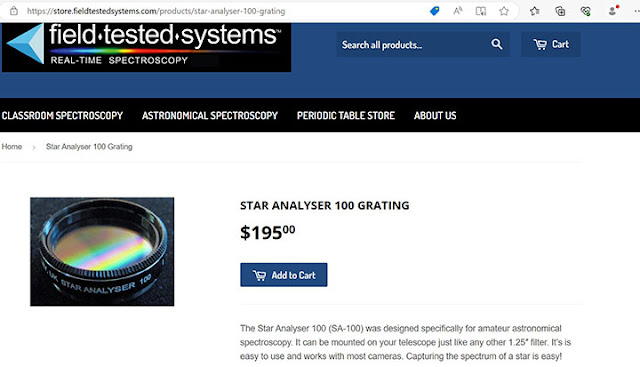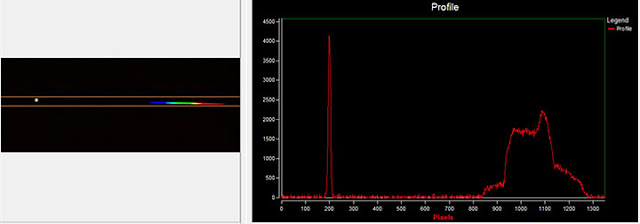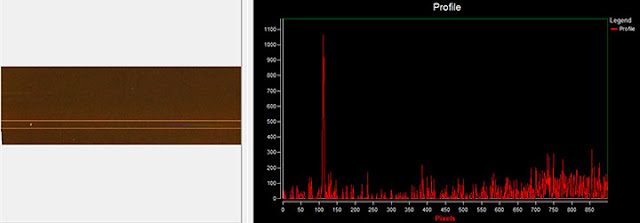Greetings from Palmia Observatory
This blog post covers the first four images to be processed by Rspec software in a first attempt to calibrate the observed SA-100 spectra camera image and convert the pixels to wavelengths.
An easy way for amateurs to get started in actually doing some visual light spectroscopy is with the SA-100 Star Analyzer, available from Field Tested Systems. This company was founded in 1995 by Tom Field, who has attended local conferences like the Society for Astronomical Studies held locally in Ontario, CA. This Resident Astronomer has attend the symposium many times in the past and this year's conference is held on June 22-24. If you want to attend their symposium heck out the details at their website : SAS. The SAS symposium is a great local, low cost meeting where you an interact with other amateurs who try to do real scientific type observations.
The SA-100 is available on Field Tested Systems website at: Star Analyser 100 Grating – Field Tested Systems
 |
| Field Tested Star Analyzer 100 Grating (Source: Field Tested Systems) |
The SA-100 is sized to fit in the 1.25 inch diameter filter wheel used by many amateurs. For me, as the lazy astronomer, prefer to just use the available adapter to screw onto the DSLR telephoto lens.
Let's look at one of the first test cases using the SA-100. The SA-100 was connected to the DSLR and the flimsy tripod was just moved into the garage for some spectral testing of two green LEDs. The green LED was behind a diffusing lens that is part of the Tesla Wall Charger. The red LED was constructed out of a red-light flashlight, used at star parties, but covered with some tin foil with a small hole poked in it. See below.
 |
| Red and Green LEDs with SA-100, DSLR, 110mm, 1/30 second (Source: Palmia Observatory) |
You notice right away that both red and green lights are positioned at about the same horizontal position in the camera frame but that the spectral lines of the red light show up just a bit further to the right than does the green. This is to be expected because the red light has longer wavelength. You can also notice that there is lot of extraneous light that is reflected off of automobiles in the garage and you can also see both red and green lights have a weaker, less bright 1st order diffraction image to the left of the 0th order.
Ok, let's take this image and do some analysis using the Rspec Spectroscopy software. You don't have to worry about taking the image so that it is perfectly horizontal because the Rspec software easily allows you to rotate and select just the portion of the image you want to analyze. In this first screenshot we see the red LED has been selected for spectral analysis.
 |
| Red LED with SA-100 and Rspec Spectral Software (Source: Palmia Observatory) |
Next we can adjust the software cursor to do analysis of the green LED. This spectral display is much more peaked than was the red LED.
 |
| Green LED with SA-100 and Rspec Spectral Software (Source: Palmia Observatory) |
Ok with this first test of the SA-100, or at least the first test other than the earlier test that occurred about 5 years ago, it is now time to take the SA-100 and camera on flimsy tripod outside and look at some celestial objects.
Let's first look at an earlier image of the sun using the SA-100 tool. This is DSLR IMG5798, 300mm, 1/1000 second exposure.
 |
| Spectral Image of Sun with SA-100 Grating and Rspec Software (Source: Palmia Observatory) |
This image of the Moon with SA-100 is DSLR IMG5811, 300mm, 1/500 second exposure.
 |
| Spectral Image of Moon with SA-100 Grating and Rspec Software (Source: Palmia Observatory) |
This image of Venus with SA-100 is DSLR IMG5808, 110mm, 1/2 second exposure.
 |
| Spectral Image of Venus with SA-100 Grating and Rspec Software (Source: Palmia Observatory) |
Now we are still left with trying to identify the camera pixel location with the wavelength of the incident light. To convert from pixel location to wavelength location we need a standard with which to calibrate the system and measurements. The Rspec recommendation is to use a Type A star which has very well defined Balmer lines. Vega is one such star that is visible in the night sky now.
This image of Vega is DSLR IMG5813, 300mm, 8 second exposure.
 |
| Spectral Image of Vega with SA-100 Grating and Rspec Software (Source: Palmia Observatory) |
It is not easy to see much of the spectra or identify any peak. So, until we get a brighter image of a Type A star with a useable spectral image, we will just have to wait to calibrate the previous images and convert them from pixel locations to wavelength locations. We might find that we need to go to a dark sky location to get a good calibration star spectrum. We maybe be able to use laboratory type source of well-defined wavelength to calibrate our camera with SA-100 Star Analyzer. More investigation or patience is needed.
Until next time,

No comments:
Post a Comment